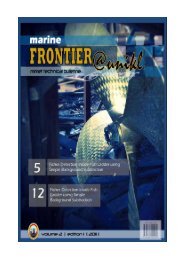click here to download - UniKL MIMET Official Website
click here to download - UniKL MIMET Official Website
click here to download - UniKL MIMET Official Website
You also want an ePaper? Increase the reach of your titles
YUMPU automatically turns print PDFs into web optimized ePapers that Google loves.
<strong>MIMET</strong> Technical Bulletin Volume 1 (2) 2010<br />
Feature Article 9<br />
TIME‐DOMAIN SIMULATION OF PNEUMATIC TRANSMISSION LINE<br />
MOHD YUZRI MOHD YUSOP*<br />
Deputy Dean Academic & Technology<br />
Malaysian Institute of Marine Engineering Technology, Universiti Kuala Lumpur<br />
Received: 28 Oc<strong>to</strong>ber 2010; Revised: 2 November 2010; Accepted: 2 November 2010<br />
ABSTRACT<br />
Pneumatic equipment is widely used in industries for transferring energy or signal. Efficient modelling and simulation in<br />
time domain for gas filled transmission line is of great importance that will provide the foundation for complex pneu‐<br />
matic systems. The basic physical relationships in pneumatics are well established. In this paper, the finite difference<br />
model combined with the lumped model is used <strong>to</strong> simulate the dynamics of air filled polyurethane pneumatic transmis‐<br />
sion line in time domain. Compared with the experimental data, the simulation results show certain consistency, espe‐<br />
cially in the response frequency. The radial expansion of the transmission line due <strong>to</strong> high working pressure is also con‐<br />
sidered in the simulation algorithm.<br />
Keywords: Pneumatic, transmission line, time‐domain simulation, finite‐difference, lumped modelling.<br />
INTRODUCTION<br />
In recent decade, t<strong>here</strong> has been great devel‐<br />
opments and interest in utilising pneumatic<br />
system as a transmission medium. Advan‐<br />
tages of pneumatic systems are that pneu‐<br />
matic components are relatively cheap reli‐<br />
able and can be easily and cheaply main‐<br />
tained. It is also much cleaner than hydraulic<br />
systems. However, the elastic nature of the<br />
compressed air will pose difficulties in achiev‐<br />
ing high accuracy control.<br />
T<strong>here</strong> are mature theories on steady state<br />
analysis of pneumatic systems but the dy‐<br />
namic analysis of pneumatic systems still re‐<br />
quires further research. Manning (1968) used<br />
the method of characteristics for pneumatic<br />
line flows. The perfect gas state equation and<br />
the isentropic relations, <strong>to</strong>gether with the<br />
perfect gas relation for sonic velocity are used<br />
<strong>to</strong> replace the density and pressure in the<br />
continuity and momentum equations by using<br />
*Corresponding Author: Tel.: +605‐6909004<br />
Email address: myuzri@mimet.unikl.edu.my<br />
the velocity terms. For simplicity, the heat<br />
transfer, viscosity, three‐dimensional effects<br />
and local changes in entropy across travelling<br />
pressure waves are neglected. The determi‐<br />
nation of characteristic lines is the key point<br />
of this method. Separating the transmission<br />
line in<strong>to</strong> sections and treating each of them as<br />
a volume in time‐domain simulation has pre‐<br />
viously been investigated by Krus (1999) and<br />
(Xue and Yusop, 2005).<br />
Krus (1999) established the distributed model<br />
according <strong>to</strong> the state principle of thermody‐<br />
namics. (Xue and Yusop, 2005) meanwhile<br />
utilise the equation of flow passing through<br />
an orifice <strong>to</strong> calculate the mass flow rate.<br />
Considering the transmission line as an elec‐<br />
tric circuit, the time domain models were<br />
established by Franco (2004). This paper in‐<br />
vestigates the time domain simulation of a<br />
pneumatic transmission line. The one‐<br />
dimensional Navier‐S<strong>to</strong>kes equations are<br />
| MARINE FRONTIER @ <strong>UniKL</strong><br />
106



